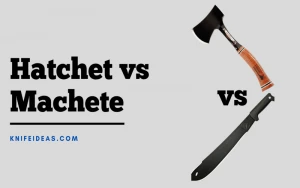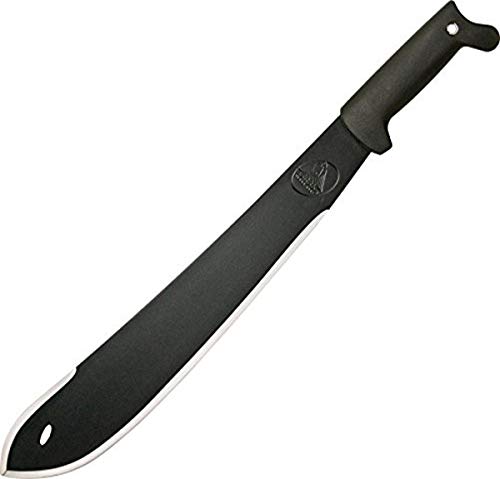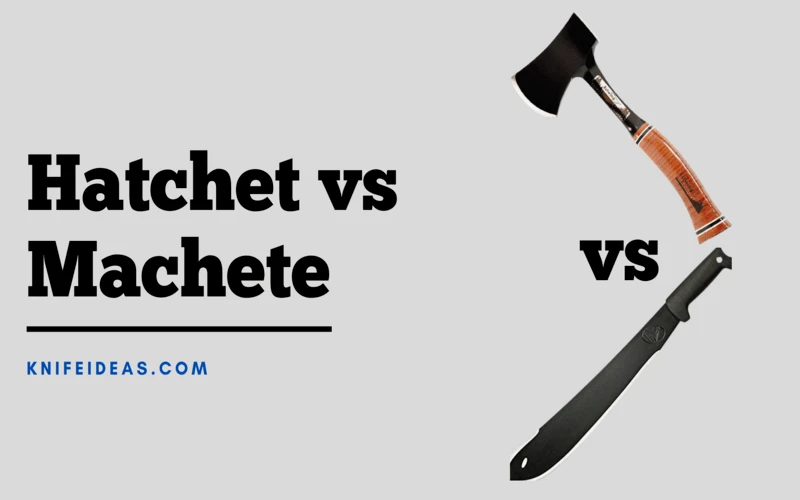Hatchet vs Machete – Which is better?
by Terry R.
Are you still confused about the hatchet vs machete debate?
If so, let us help you select the top one for you. Not every outdoor adventurer knows everything about chopping tools and their functionality.
That is why help from the experts in this regard can save you from a lot of potential problems.
The tools under discussion are significantly different from each other based on the physical features and the overall functionality.
In this hatchet vs machete debate, we are here to distinguish a hatchet from a regular machete. After reading the guide carefully, you will be better positioned to decide what particular tool you need.
We have tried to include every detail regarding the tools under consideration. We described the pros and cons after analyzing the definition and functionality of the two items. Additionally, we described the in-depth differences between the two to help you understand which one suits you the most.
You should keep track of each item's weaknesses and strengths while you read the article. This thing will help you decide the winner.

Hatchet vs Machete - Comparison
Finest Kukri

Finest Machete

Hatchet
Originating from Germany, hatchets are handy tools for cutting and splitting wood. You can use the tool single-handedly to cut through a variety of things due to its top-notch striking power.
When it comes to the design, you will find an extremely sharp blade on one side and the hammerhead on the other side for a perfect combination of power and balance.
A standard hatchet turns into a hewing hatchet when users utilize it for hewing. In other words, when users optimize the hatchet head to level the log's surface, a common hatchet becomes a hewing hatchet. It is highly safer for novices to operate the hatchet because of its impressive design and overall structure.
Do you know that a hatchet is different from a hand ax? If no, let us explain the difference between the two. You will notice a flat button on the opposite side of the head in a hand ax.
On the contrary, the presence of a hammerhead on the back of the hatchet is the defining feature of any hatchet. The hammerhead's absence makes a hand ax, while the availability of a hammerhead makes a hatchet.
The manufacturers use a variety of steel types to make the head of hatchets. You should select the quality that matches your needs and requirements.
When it comes to the haft or long sturdy wooden handle of the hatchet, the length is the deciding factor. Usually, you will notice a length of 18 inches that helps in one hand wielding.
Applications of a hatchet
When you are out for heavy-duty chopping, you can certainly depend on a hatchet. A hatchet does a variety of jobs for you. It works exceptionally well for alpine chopping without any hassle.
You can easily cut through wooden material due to its bulky head. In the absence of a pocket knife, it gets done the work of a pocket knife. People use it to produce fire using the spark and friction it produces.
Pros of Hatchet
● Sturdy handle
● Perfect for newbies as it offers safe usage
● Easy to maintain balance
● Suitable for heavy-duty chopping
Cons of Hatchet
- It is not a perfect combat weapon.
● It requires more power to execute the chopping.
Machete
Machetes are cutting tools that are found everywhere we go. There is a large variety of machetes tools that define its functionality and usefulness.
People from every corner of the world use a machete in one form or the other. Historically, people from various Central American countries have been using this cutting tool for multiple purposes.
The availability of a wide variety of shapes and sizes of machetes enhances the device's desirability among various customer segments. The presence of a swooped belly below the tip is the defining feature of machetes.
This swooped belly is the result of a heavy-duty blade that gets prominent towards the end. The presence of a sturdy 12 to 18-inch blade in machetes helps the tool outperform many others when chopping medium things.
Usually, the thickness of the blade is between 2 and 3 inches, which also adds to the device's desirability. The traditional associations of machetes are also worth mentioning.
It covers a significant portion of the national flag of Angola. The presence in the flag depicts farmers, agricultural output, and armed struggle. People in some parts of the world use it as a performance weapon in their cultural dance.
Applications of a machete
There are plenty of applications in agriculture and farming. People in some parts of the world utilize machetes for harvesting crops such as sugarcane. People in tropical and subtropical regions of the world use it to deal with rainforest undergrowth.
Additionally, there are several commercial uses of the product. Artisans use them for making wooden handles. Professionals use the tool to split through coconuts. Besides, you can use it to clean brushes, cut animals' food, and eliminate trees' unwanted branches.
Pros of Machete
● Top-notch sturdy blade
● Swooped belly for enhanced chopping power
● Second to none when it comes to fishing
● Perfect for clearing unwanted bushes and branches
● Excellent chopping power
Cons of Machete
- You cannot use it for animal dressing.
● It can be a little dangerous for novices due to unsafe swing.
Hatchet vs Machete - Key Differences

It is undoubtedly a fact that many uses of hatchets and machetes overlap. People from across the globe use them for different purposes. Therefore, we would suggest you look for the strengths you want from the tool and avoid the weaknesses you want to skip.
The following are crucial differences between a hatchet and machete in a hatchet vs machete contest;
Shape and design
The first one is the critical difference between the two in shape and design. The shape and structure of a hatchet are drastically different from that of a machete. The overall size of the hatchet is more significant than that of a machete.
You will find a sharp blade on one side of the hatchet, while the other side contains a hammerhead that enhances the tool's striking power. The presence of a long handle is a prominent feature of hatchet tools.
The grip helps in the execution of more significant force for a top-notch striking power for heavy-duty chopping. On the other hand, a long blade and a smaller handle allow it to be used for many purposes.
You can do a lot of light to moderate farming and agricultural cutting with the help of a regular machete. It can also serve as a compact weapon to guard against any possible threat.
Cutting Edge and Blade Style
When it comes to blade style and cutting edge compared to hatchet vs machete, the blade's overall size and cutting edge on a hatchet is smaller than that of a machete.
The blade is designed to execute heavy-duty jobs. Therefore, the blade-style requires the users to exert more power to have a needed chopping power.
On the other hand, the blade on a regular machete is larger compared to the hatchet. The edge is suitable for light to moderate chopping jobs, and it requires less execution force to accomplish the task.
Weight and Balance
The weight of different variants of the hatchet may vary from seller to seller. However, the overall weight of the hatchet is greater than that of a machete. There are several possible justifications for our claim. More specifically, due to a larger handle, the hatchet's weight surpasses the weight of a machete.
In our opinion, the hatchet outperforms a machete when it comes to maintaining a balance during use. The availability of a larger handle design and a smaller blade size offers significant balance in the case of hatchets.
Cutting and Chopping Power
A hatchet offers more chopping power than a machete. The design and overall structure of the hatchet allow for greater chopping power. That is why we recommend using a hatchet for heavy-duty jobs.
However, you should keep this thing in mind that a higher chopping power means you will require more execution power that ultimately enhances the hatchet's chopping ability.
Handle and Tang
When it comes to handling and its usefulness, the hatchet is a sure winner. The availability of a longer handle enables users to apply more significant power. As a result, hatchets offer better chopping power and suit high-demand chopping jobs.
Portability and Ease of Use
When it comes to portability and ease of use, a machete is an absolute winner. Its overall compact use and ease of operation allow for greater portability.
Conclusion - Hatchet vs Machete
In this detailed hatchet vs machete comparison, we have tried to help you select the winner by providing details such as definitions, usage, pros, and cons of each tool.
Additionally, we highlighted the main differences based on physical features and other attributes. The description of the differences will help you select the one that ideally matches your needs and requirements.
However, the basic concept revolves around the understanding of your needs and requirements. This hatchet vs machete contest was meant to help you define your requirements.
Therefore, we would advise you to express your requirements before you make a final choice regarding Hatchet vs Machete.
About Terry R.
Hello everyone, Nice to meet you!I'm Terry. The man behind the sweet revelations blog. I'm a father of two energetic kids. I grew up in New York. I love to read books. I like to spend most of the time with my family and friends. I used to learn new things and wish to share my knowledge with others.
Thoughts on "Hatchet vs Machete – Which is better?"
 |
 |
 |
 |
Kitchen - Outdoor